Current bikes
2012 Honda CrossTourer VFR1200X
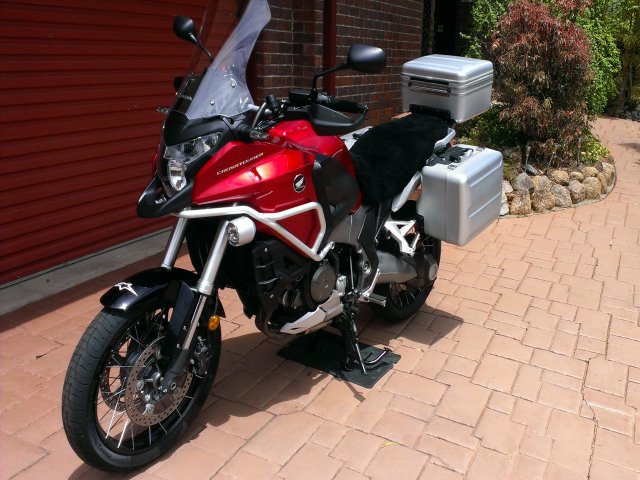
A new ride has joined the family. This style of bike has been on the drawing board for a couple of years now as a result of going places and not being able to explore off the bitumen to any significant degree. The opportunity to also slow down the accumulation of kilometers on the Goldwing was part of the thinking. The final catalyst was an opportunity to undertake a special project if all the balls could be made fall in the right order. More on that at a later date.
A lot of research and a few days of looking at different brands/models/engine capacities/pillion comfort resulted in choosing the VFR. Unable to source a test ride, we decided to try a second-hand one. It passed the ride comfort and handling test as the owner had modified the suspension to improve the ride, handling and pillion carrying ability. With most things fitted already, panniers, topbox, protection bars, lights and tall screen, we elected to go with the this one rather than start the build-up of a new one. I've since fitted a sheepskin seat cover, centre stand and a Givi Topbox which is large enough to hold a helmet,jacket and gloves. Future changes will include fitting a GPS, getting charging power into the topbox and probably some protective gear like a bash plate and radiator guard.
With around 3,000 klms covered in a couple of months including longer trips fully loaded, the bike has passed the test and seems suitable for its intended purpose. That means that the Deauville which has served me so faithfully will have to be moved on. Room in the garage is pretty tight at the moment.
The "intended purpose" of this bike was to undertake a 2 - 3 month ride around the USA and maybe Canada. Obviously, it was never going to be as comfortable as a Goldwing and when we researched the options of using a Goldwing for the trip; hire, purchase and sell, ship ours over and back, it became clear costs became prohibitive. The final decision was to set the VFR up for the trip as it was much cheaper to fly the bike to Los Angeles, bring it back by ship, and insure it.
Dates for the trip were to work in with our sons wedding which was to take place on Mexico and shipping arrangements, who would do it, dates, crating etc. were sorted out and just before putting the plan into action, an opportunity arose to hire a private GL1800 from a person in Vancouver, Canada. A great decision and one we have never regretted. You can read that story here.
As it turned out, I fell in love with this bike. as I always seem to as I conside a lot of things before making a purchase and grnerally get it right. As a result, the idea that we might sell it on our return didn't happen as I started to ride a lot more with a group of other week day riders and this bike was ideal for the task. More so that the Deauville.
2007 Honda GoldWing GL1800
After months of thinking about it and pondering the most appropriate replacement for the now long in the tooth GL1500, we finally decided to commit to a new 2007 GL1800. Why? Well, it fits our lifestyle better than anything else. In spite of the fact that I have never been sold on the styling, there is no doubt that in my opinion, the 1800 Goldwing is the best all round option for long distance touring in comfort.
In Australia, the 2007 came with the comfort pack of heated seats and grips, hot air vents, CD player, driving lights, ABS brakes and pannier and trunk bags. As with most Goldwings, the initial purchase price was the least expensive bit, it's the accessories that cost the real money. Immediately after purchase, it was fitted with a trunk rack, tow bar, CB radio and sheepskin seat cover making it ready for the long rides. There have been many more extras such as lighting and chrome all aimed for personalisation of ours amongst our group of friend's Goldwings.
Eighteen months down the track and the bike had done 26,000 klms, half of it fully loaded two up with the trailer. It has been as good as expected. The bike has performed flawlessly except for a replacement CD player and with nothing more than the regular servicing. The bike has now done 47,000 klms and continues to perform well. The biggest problem has been a leaking left hand radiator. Apparently a known problem in the 2007 model in the USA where Honda has replaced the radiators under warranty. Not so here.
110,000 kilometers down the track including a trip around Australia and rides to Victoria for fun and the Australian round of the World Superbikes, apart from the normal maintenance requirements, the only additional work performed on the bike has been a significant suspension upgrade. New springs and a bypass of the anti-dive had been fitted before the round Oz ride but the suspension was still a bit harsh and was getting a bit sad, front and rear. The changes involved revalving of the front forks using the same heavier springs and a similar revalving of the rear shock together with a significantly heavier spring. What a change, should have done it from new. The bike now rides like it should have from new, absorbing the bumps a nd potholes, not crashing through or over as it always has done. Looking forward to the next 40,000 klms.
2002 Performance Trailers Aero FX
I swore I would never tow a trailer. Too much space and therefore too many chances to overload. Towards the end of 2007, we started planning for a round Australia trip in 2010. The intention was to spend up to three months on the road and for that we would need a fair amount of equipment and I was sick and tired of crawling on my hands and knees in and out of a cramped tent. With the desired tent being a single pole tourer type, this was to dictate the size of the trailer or at least, the trailer had to be able to accommodate the tent.
Basic requirements were light, not too large, preferably with brakes, good handling and smooth ride. I'd previously had a trailer behind the car that could unscrew the lids of bottles. Not good when it's the sauce bottle, ask me how I know. Due to an anticipated limited use requirement, anew trailer was not seen as an option if something acceptable could be found, so that meant regular monitoring of the internet adds to evaluate what was available. Months of monitoring the various home-made, Classic, Bandicoot, Ali-Lite and many more trailers that, while being able to fit the tent, just did not meet what I was looking for. The only one that came close was the Performance Trailers Aero FX. Brakes, independent suspension, aerodynamic, 85 kgs tare but could not take the tent in its designed format. Not to mention that I considered them too expensive new and the rare second hand one was usually dearer that many of the others new. One of the benefits coming from the support dealers give to the Ulysses Club AGMs was that I had been able to see the Aero FX trailers and could understand why they were so expensive but could still not justify buying one. Then it happened; an Aero FX only a few years old and only having done about 5,000 klms was advertised at an abnormally cheap price. It was close at hand so an inspection prior to purchase was essential to see if it would be possible to fit the tent and other things as I had figured there was no way the tent would fit using the manufacturers folding process. There are always possible options to make it work and many of these were considered during the inspection and indecision over the purchase. Then a strange thing happened. The longer I thought about it, the lower the price went without me even having to negotiate it until only a fool would have let it go; even if it might not fit the bill.
Over 12,000 klms later the trailer is certainly fitting the bill. Its ride is everything you could want, it doesn't even shake the stubbies up. Carries every thing we need but as usual, more space would be good. It's not that it's small, just that the shape can make it hard to load when there is a big tent and an esky that has to fit inside. Carrying an esky on the front would place more than the preferred weight on the bike tow bar and would also upset the aerodynamic flow, a big benefit of the trailer. With the trailer no wider than the bike, even fully loaded two up, it causes very little reduction in the fuel economy of the bike.
The trailer had a tendency to leak some water around the front of the lid and some chassis alignment issues from what appears to have been a significant bump at some stage of its life. These were cheerfully addressed by the manufacturer at a very reasonable cost. It appears this was one of his earlier ones and it has now been bought up to later model specifications.
Finally, in 2011, the Round Australia Trip will finally occur in company with friends on their 2008 Goldwing. A decision to manage most meals ourselves means that we will need to carry a kitchen supplies box, something that we usually don't do. To do this and to make the daily tent unpack and pack easier and able to be done without partially unloading the trailer, a rack and waterproof bag has been be fitted to the lid.
Bikes we've owned
1971 Honda CB750K
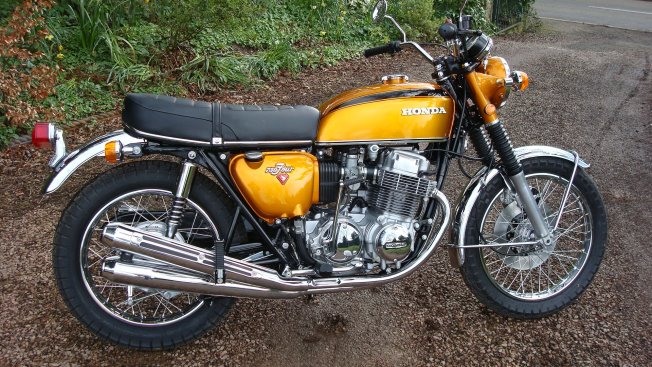
In 1971, after a couple of years riding mate's trail, motocross and street bikes, and many years of push bike riding, I was finally old enough to get a licence. This was in 1971 and what would be more suitable for a big bloke than the just released second model of the new across the frame 4 cylinder Honda CB750? This was the now rare and revered CB750K1. This engine format was to become known as the UJM, Universal Japanese Motorcycle, as all the other Japanese manufacturers soon followed suit.
Of course, the bike had to be red, just like the brochure. All good Hondas were red and after all, it is the fastest colour. Too bad as far as Honda were concerned, only gold ones came in in that shipment. Well, a bike in the hand is worth more than waiting and so it was to be a gold one. Little did I know that this theme would continue for many years.
The bike was set up with two personalities. In sports guise, the bike was fitted with either clubman or flat bars, Koni shocks, custom front and rear mudguards and a four into two megaphone exhaust system that at full cry with the baffles removed, could be heard literally for miles. In touring guise, the bike was fitted with a set of leather saddlebags on a frame robust enough fully load and to strap gear on top as well. Not to mention the sleeping bags slung under and over the headlight.
Over the next couple of years, the bike toured Queensland, New South Wales, ACT, Victoria and South Australia. During the time I owned it, I wrapped up around 40,000 miles, 64.000 klms, with no problems except for the common to all, leaking head gasket that required replacement. Of course, there's no need to mention the numerous chains, sprockets and tyres that seemed to disappear at all too regular intervals. The bike was only involved in one major accident in that time, when my enthusiasm exceeded the bikes cornering ability and the back wheel, between the guardrail and the bitumen surface, passed the front wheel which was still on the bitumen surface. Not a major problem until the the rear wheel found the bitumen again. This resulted in the bike flipping a couple of times. The resulting repair work presented the opportunity to repaint it. The repaint was a bright green flake with 24 carat gold pin striping. The colour soon lost its appeal and the bike was soon repainted in Dulux Wildfire Black Magic with 24 carat gold pin striping. A beautiful result that drew many comments.
The bike was sold eventually sold to purchase a car and for the following couple of years, with the exception of the short lived Kawasaki F5 below, this became the only period when I would not have a motorcycle.
(Unfortunately, I have few photos of this bike. The above is one from somewhere on the internet.)
1971 Kawasaki F5 350 BigHorn
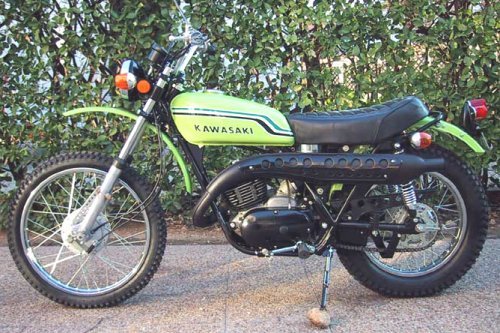
1974 and having been in cars for a year or so, the motorcycling bug began to bite again and something was needed to at least let off some steam. A mate happened to be selling the big Kawasaki and so it was purchased as a play toy and very little else, my only non-Honda to date . What a piece of machinery. The Big Horn was At the time, these things had so much low down torque that wheelies were never further away than a twist of the throttle. As a toy to have a bit of fun with, a wheelie competition with a mate in his back paddock resulted in a fall off the back where the number plate came down on my calf just above the riding boot and promptly bit a 5 sq cm piece out of my leg. This resulted in a few weeks in hospital and bed and a scar I carry to this day.
And you know what? To this day, I cannot recall what happened to this bike. I assume I must have sold it but I have no idea who to, why or when.
(Unfortunately, I have no photos of the bike. The above is one from somewhere on the internet.)
1975 Honda GoldWing GL1000
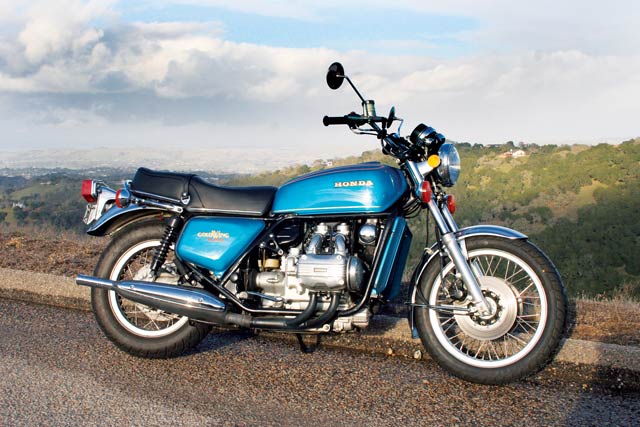
1975. Honda does it again and releases a bike that was to again change the face of touring motorcycling. That beautiful smooth water-cooled flat four cylinder engine. Enough of cars as the primary vehicle, the new Goldwing beckoned. The V8 panel van was sold and down to my mates Honda dealership to collect one of the first GL1000s sold in Australia. Of course, after the CB750K1, the bike had to be red. Again I was thwarted as the blue-green one was on the floor and the deal was better to move it rather than order in a red one. Funnily enough, the replacement floor stock was red, but more on that later.
What a motorcycle, no wonder these were an icon and are still sought after today. This was the smoothest machine around and while not the fastest or most powerful, in setting the standard for future Goldwings, this was a comfortable mile muncher and it could lift its skirts and run when required. And this was required often in the first three weeks. One old photo shows it in hill climb beating a 900 Z1 Kawasaki of the concrete start pad in a dirt hill climb, other photos show it on a dirt short circuit track against a number of other street and dirt bikes. Good fun, and the abundance of dirt and gravel roads saw all our bikes needing to be good unsealed road machines.
Why was it only required to do this for three weeks you ask? Unfortunately, the GL1000 was never endowed with the ground clearance of a sports bike and it met an untimely end when the combination of cornering speed and the required lean angle was too much for the limited ground clearance provided. With the centre stand not providing the same level of traction as the rear tyre, the result was inevitable, as was the skin abrasion, strained muscles etc., that come from a high speed slide. Unlike the bike, I didn't hit anything and do serious damage but the bike ended up against the table-drain embankment and the damage and bent frame resulted in it being written off.
It lived to fight again with a friend of a friend buying the wreck, straightening the frame and repairing/replacing the panels. He got a cheap, near new Goldwing with only a couple of thousand kilometers on it and it is probably still going.
(Unfortunately, I have only one photo of the bike apart from those after the accident. The above is one from somewhere on the internet.)
1973 Honda Elsinore MT250
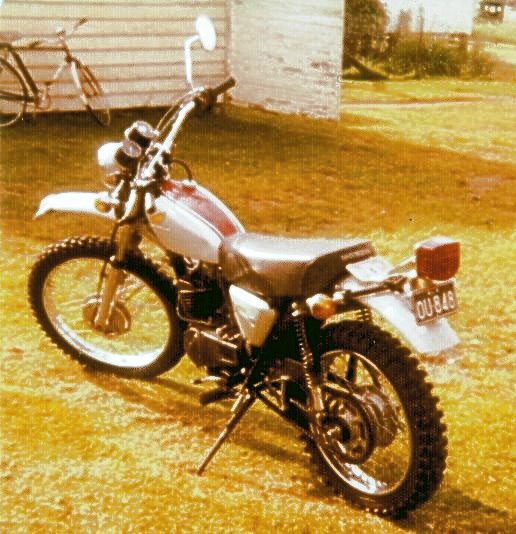
With no car and the GL1000 awaiting finalisation of the insurance claim, wheels to get around were required . As a temporary measure, why not something light and easy that a bloke could have some fun with. Like the Kawasaki, another mate was getting rid of an Honda Elsinore. A Honda two stroke single? Not a great reputation as a powerful machine but it would be OK for day to day work, so it became the short term ride. Definitely not a powerful performer but it certainly was good fun in the wheelie stakes. Required balance skills rather than just the use of power. Over a period of a couple of months ownership, the bike did many trail rides in the surrounding mountains. Riding in the mountains requires either a lot of torque or a lot of revs. Being used to big engines or torquey singles, my trail riding usually resulted in a fair amount of uphill pushing as, with the limited amount of torque available, my failure to use bulk revs and a big bloke on board, climbing long step hill trails was not its forte.
The bike was a fun play and did the daily run to work and weekend play until it was sold to move on back to road riding.
1975 Honda GoldWing GL1000
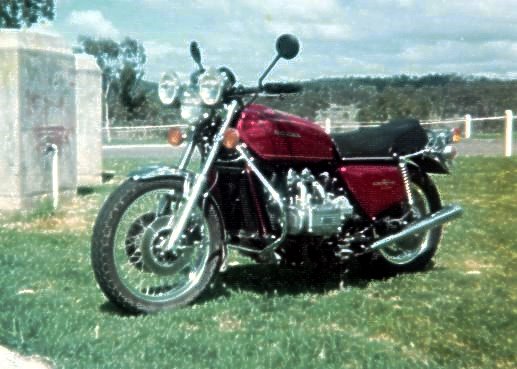
With the insurance cheque from the first GL1000 in hand, it was back to my mate the Honda dealer for a new one. At long last, I was able to get the red Honda I had tried for on two previous occasions. And what a beautiful Candy Red. The bike was immediately named Pegasus because what else that big could fly. It was interesting to compare this bike to my previous Goldwing. Very little difference in time of build, both landed in the same shipment, but they were like chalk and cheese. The first GL1000 had power to burn, accelerated like a sports bike and used fuel at a high rate. This second one was the opposite. Still just as smooth, but didn't have the urgency and was far more economical.
Back into touring mode again and the bike was fitted with hard panniers, nothing like those of today though, and a set of driving lights. I did a lot of night riding in those days and still enjoy a night ride. I love the cool night air, the feel of the added performance, even if it is an illusion, and the ability to see whatever other vehicles are coming, all add up to a pleasant riding environment. The touring changes were followed up with the removal of the standard heavy U shaped exhaust system and the fitting of a set of large capacity Dunstall reverse cone mufflers with a balance pipe. What a beautiful sound. One of the most beautiful sounds I've ever heard from a flat boxer four engine.
No long tours in the first few months but quite a few thousand kilometers covered in short and long days rides. This was the bike that Therese first joined me on, with her first ride also giving her an introduction to riding in the rain. Beautiful bike and a smooth and comfortable ride. Provided you accepted the limited ground clearance available it was a great long distance tourer. After a four hour early morning ride in almost zero temperatures, the bike developed what seemed to be a slight knock in the bottom end. With it just out of warranty and not wanting to have the bike stripped for a look see, it was given a change of oil and some additive to assist. There was no further recurrence of the problem. Unfortunately, for the distances I like to travel, a lack of confidence in its long term potential meant that I preferred to move it on, so it was traded on a CB750F Super Sport a couple of months later.
1976 Honda CB750F Super Sports
Funny how things never work out. Still in love with red but again, it was unobtainable. Had to settle for a yellow one. No problem with that, just not red. The Super Sports was an improvement on the K1 but not by far. Same motor with only minor changes, the loss of the K1's chain oiler was one. The F handled a bit better, didn't go any better but did accelerate harder due to a lower geared final drive. Always wanting to be a little different, the bike immediately received the individual treatment and touring preparation with the fitment of a bikini fairing, the panniers off the GL1000 and a Walker exhaust system.
Rode the bike for a few months but wanted something different. How different can you get but fitting a sidecar. See below.
1976 Honda CB750F Super Sports fitted with Chariot Sidecar
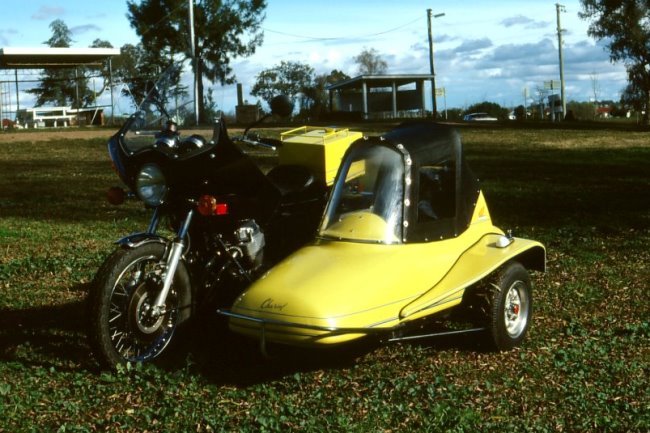
Why not be a little different. How much different could I be by having a sidecar. I'd always had a fascination with outfits. Used to work with an old bloke who had a 1932 BSA side valve twin he had bought new then fitted a chair in 1934. Fantastic outfit, he was in his seventies when I had started working with him a few years earlier and it was still his daily ride. He and his wife had never owned a car.
A lot of research was done on the limited number of sidecars available but eventually settled on a Chariot as I thought it was the better looking and more stylish than the more common DJP.
Fitting the chair was a bit of trial and error combined with experimentation and testing until we got it close to right. Always wanted a leading link front end but availability wasn't as easy then as it is now. The fine tuning continued until I sold the bike many thousands of kilometers later.
Fitted with a copy of a Windjammer fairing, the outfit became a primary form of travel for Therese and I. The lack of grunt proved a bit of a problem when trying to keep up with mates on their solos. To get performance it meant gearing the bike down from standard. Combining this with the extra drag and weight, fuel consumption became more of an issue on the long hauls. That resulted in the modifications you see above where the dual seat was replaced with a solo seat and a 20 litre fuel tank fitted to the rear. The pulling power issue was addressed through the fitting of a 820cc engine kit and the improvement was such that I could return it to standard gearing.
In 1978 we moved to Cloncurry in western Queensland where the touring continued with long regular runs to Townsville and Cairns until we bought an air-conditioned car to combat the prevailing temperatures. This meant the chair spent more time off than on. Being able to convert to a solo was an advantage of not having a leading link front end. Eventually, around 1980, the call of the open flat lands and distant hills of the area called too strongly and the outfit, which was getting less and less use, was sold to purchase a trail bike so I could at least ride with the other riders in town. There were no other road bikes in town at the time.
The 1979 Honda XL250
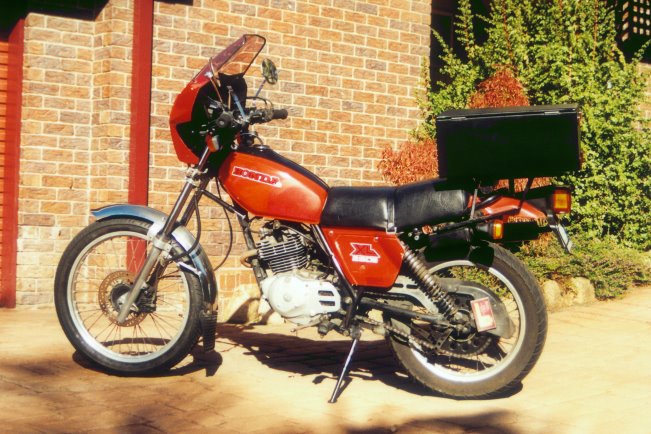
This one was delivered still in its box. I had worked for a Honda dealer doing all his assemblies so when I needed to purchase this one with no Honda dealer in the immediate area, the simplest solution was to have it shipped directly to me for assembly and pre-delivery. Finally a red bike,couldn't go wrong this time, it was the only colour it came in. The bike was to become a very versatile motorcycle and was to become the motorcycle I have owned for the longest time. Why? because of its veniality and my changing life style.
This model XL250 was different due to the use of a 23 inch front wheel. Great for off road use as it ran over rough ground very smoothly but was to become a problem in later years when changes to tyre requirements became a priority. Over the next three years in Cloncurry the bike was used to go to and from work during the week and ride the outback plains and hills to explore places I would never have got to otherwise.
We later moved to Maryborough where, apart from a couple of 300klm round trips to Brisbane, the bike became a commuter for the daily work run. After all, a man's got to earn a living. On a couple of occasions on dirt I had a couple of front end washouts that seemed to be the result of that narrow front tyre. It was a universal tread that while the large diameter rolled over bumps while vertical, it was not the best when leaned over. This was to prove a major undoing when I was rounding a bitumen corner with some loose gravel and it dumped me on my knee and put me on crutches and slowed things up for a while. By this time children had come along so motorcycling was not high on the agenda. Commuting was the order of the day and we later moved to Bundaberg where its role as commuter continued.
Moving to Barcaldine meant that commuter services were no longer required; small town, two block walk to work, so with a couple of modifications, a rack was added to the back so the golf bag and buggy could be carried to the golf course a few times a week. Eventually the bike was de-registered but retained for probable future use.
In 1998, almost twenty years after buying it but with only 20,000klms on the clock, the XL was reregistered to become the daily commuter again when we moved to Brisbane. With all bitumen work on city streets, the best solution was to convert the trail tyres to street tyres. No problem for the rear but the front was a different story. Eventually I was able to source a later model frame less motor for a couple of hundred bucks. The front end of that bike had a 21 inch front wheel and disc brake. The later model front forks were fitted and the wheel fitted with a street tyre. The limited modification meant that the bike could still be converted back to trail use.
Four years later, with 46,000klms on the clock, a box on the back for the briefcase, a handlebar fairing to keep the cold morning air at bay, a new set of rings and many other electrical parts replaced, it was finally time to move old faithful on, 22 years after the original purchase.
1993 Honda GoldWing GL1500A Aspencade
October 1996 and before the XL250 was put back on the road; was it was a mid-life crisis, a need to do something different, the fact that the kids were now growing up and there was a need for a second vehicle at times? Maybe a combination of all those or maybe the prompting of a mate who was sick of riding by himself. Which ever it was, it was time to get back into road riding. With the XL250 sitting in the shed unregistered and not suitable to the distances involved with going anywhere in any direction from Bacaldine, it had to be a road bike. A sports bike was never going to meet my requirements based on my earlier riding requirements and having been out of biking for a few years, I didn't even know what was available. What I did remember however was my two previous early Goldwings and the full dress 1100 and 1200 models that followed. As a Honda man it seemed to come down to a choice of the ST1100 or a Goldwing. Price was most likely to be the deciding factor. There is a rule amongst Goldwing riders that says unless you are prepared to buy, do not take one for a test ride. Unfortunately, I didn't know that then. After looking enviously at the GL1500, the ST1100 was taken for a test ride and the dealer accompanied me on a Goldwing. He obviously knew the rules so after a good ride on the ST he put me on the GL for the run back to the shop. That did it. After a few discussions with the chief finance officer and some looking at what other Goldwings were available, we became the owners of a Phantom Grey Goldwing GL1500 with a young 38,000klms on the speedo. One of the original 25 Honda Australia bought in when the Goldwing was reintroduced to Australia. (Note the addition of the colour panels to get some red)
So began an 11 year relationship with one of the most fantastic bikes of its type of the day. There are plenty of places on the web where you can read all the comments that come from owners of these motorcycles so I am not going to go into that here. What I can say is that this bike got me involved with two separate groups that have changed our lives. The Ulysses Club and the Australian Wing Riders Association Qld Inc.
Over the 11 years, the bike was used as Dad's taxi taking any one of our boys to sporting events, like 300klms each way for swimming, 1300klm round trips to and from boarding school, local runs with a full cricket bag strapped on the rack, (who said they can only carry 5kgs). A lot of riders talk about the limited weight you can put on a Goldwing top box rack. Glad they never saw a full cricket bag and two chairs strapped on mine. The bike also enabled me to travel all over the eastern states of Australia attending the annual Ulysses AGMs. Places such as Wagga Wagga, Geelong, Mt Gambier, Ulverstone and Nuriootpa and many more. For some of these stories, you are welcome to go to my Ride Stories page.
Apart from ordinary maintenance that you would expect from any motorcycle that is used on a regular basis, averaging around 15,000 klms per annum, the bike was trouble free. Wearing parts were primarily tyres, of course, rear shock absorbers, including the fitment and subsequent rebuilds of a set of Progressive air shocks, and rebuilding of the front forks and carburetors.
As with all Goldwings, each has to be personalisied and mine was no different. Some extra chrome, fork springs and fork brace to improve handling, bigger windshield and some chrome trim. While a tow bar was fitted early on, its purpose was for the mounting of a carry rack and bag, not for trailer towing. With a large family like ours, many years of towing trailers to accommodate camping requirements ensured that I had the knowledge that the more space you have, the more gear you carry. The carry rack made it possible to carry a larger tent and therefore live in a bit more comfort.
As one by one the boys started to leave home, the Goldwing became our primary form of transport and recreation until, with over 180,000klms on the clock and plans to do a Round Australia ride in 2010, we made a decision to purchase a new bike. Again, the issue of purchase cost and suitability became a key decision point and the ST1300 was a short term contender. While I had never been a fan of the looks and ride of the GL1800, preferring the style of the GL1500, eventually, for Christmas 2007, the heart, common sense, and a desire for comfort overcame my reservations and the offer of a good deal meant we took the opportunity to move to the GL1800.
1992 Honda Revere NTV650
May 2002 and the old XL250 was looking in need of replacement. What to replace it with was the question? Something similar, something with a bit more grunt, something that could better handle a life in heavy traffic was the key. After looking at a number of bikes, some rev happy 250 - 500cc twins and 4s, a couple of 250 - 650 V twins, a mate suggested a Revere. A what? Never heard of one. A bit of internet research and here was something that looked good. Not high power but a torquey twin, low revving like the Goldwing, not a sports bike seating position so easy on my back. Solid reputation and while they were never popular, owners seemed to love them. Finding one proved a bit of a problem so a step into the internet void and eventually one was purchased, red, 70,000klms, sight unseen, from an internet advert. The old bloke seemed OK and the servicing dealer details checked out. The bike arrived on the back of a transporter just as I was due to head out on a ride so it was off the truck, quick lap around the block then into the shed until we got home the next day. I liked that initial ride.
This was a bike I fell in love with immediately. The riding position was very comfortable, good economy, reliable and handled the traffic with aplomb. Fitted with a RJays 45litre top box the bike became the daily transport and never looked back. A seat base from a wrecker was given the conversion treatment for solo use and with a couple of other modifications, the bike was converted to a solo for reduced registration cost purposes.
Although I never did any long distances on the bike, it was easy to see why, in Europe where they were extremely popular, the majority of them were fitted with panniers.
Prior to releasing of the Deauville in Australia, Honda had one at a Ulysses AGM for test rides and evaluation. Here was something that might eventually be able to replace the Revere but the cost would be prohibitive.
It was a fateful day in February 2005 when a mate dropped around to tell me he had purchased another set of wheels and mentioned an advert on the internet for a Deauville. A deal was done and sadly, three bikes did not fit the riding model so the Revere, now with 105,000klms on the speedo, had to go. By a strange twist of fate, it was purchased by the same bloke that purchased the XL250 off me when I purchased the Revere almost 3 years earlier. As with all my bikes, I was sad to see this one go.
2004 Honda Deauville NT650V
Back in 2003 when Honda decided to bring the Deauville into Australia, they presented one at a Ulysses AGM. Taking one for a test ride, I was immediately reminded of my Revere. Same motor, basically the same frame etc, just add the fairing and panniers and a second front disc. End result, similar bike, about 25% heavier and lower geared to compensate. My immediate thoughts were that this could be a future replacement for the Revere, but the cost was way too high.
Roll on February 2005 and a mate turned up at home to tell me he had just bought a new bike. Knowing I liked the Deauville he pointed out an add for a 2004 Deauville with an asking price of around $9,000. Not bad seeing it had only done 4,500 klms and was a few months old. Although not wanting to spend that much to get a ride to work bike when the Revere was doing a great job, we decided to go have a look at it anyway. They only came in two colours, red or blue; you guessed it, it was a blue one. A test ride proved it to be as good as I remembered, and there would certainly be benefits in having the panniers for securing and storing gear during the day and it wouldn't be too wide to carve up the traffic. Negotiations resulted in an agreed purchase price, well under that advertised and that which I would have paid, so I now had a Deauville.
First thing was to build a removable rack for the DriRider bag. This was to enable the carrying of extra gear, like cricket bags or other bulky items and would double as the rack to fit on the tow bar of the Goldwing. For every day use, an RJays 45 litre top box, the same as the Revere, was fitted providing lockable storage for a helmet etc but easily removable when not required.
One reason for the purchase was to have a bike that was more versatile than the Revere and able to reduce the use of the 'wing and thus reduce the every increasing mileage it was gaining. The Deauville proved excellent. I found the bike so enjoyable that it became the de facto sports taxi with the cricket bag and chairs, it proved acceptable for 400 klm solo and two up rides with non-Goldwingers. It has also be known to do 500klm Goldwing rides when the Goldwing had a flat battery or when I was going solo. All in all, a great commuter and more than suitable for longer rides if one is not looking for a sports bike performance. Handling is more than acceptable for a light weight touring bike and maintenance requirements are low.
Averaging 15,000 klm per year commuting and the occasional long ride, the bike is about to pass 75,000 klms and is performing faultlessly. The bike has also proven itself as a two-up weekend tourer when needed with the ability to provide sufficient comfort for a long ride, fully loaded including tank bag and still able to run easily with the Goldwings, even when higher speeds are required.
Well, the time finally came. The Deauville was sort of motrhballed when the VFR came along. That bike was supposed to be for the trip to USA however that was done using a rented GL1800. You can read that story here. The VFR was so much fun with enough performance to run with any other bike, it became a favourite when I began doing day rides once a week of around 350km.
Now with 86,000km on the odometer, for the past almost 7 years, it has spent most of its time parked in the garage with a battery maintainer and being taken out for a 40-50km ride every few months to keep things turning over and to refresh the oil and fuel.
In May 2023, I received an offer to sell the bike. I didn't really want to but as it wasn't being used, I reluctantly agreed. After fitting another new battery and new brake disks all round, the roadworthy was obtained. The mechanic pefrorming the roadworthy could not believe the"like new" condition the bike was in. A final ride around the suburb bought back all the good feelings of riding this great little, but under-rated bike, and made me wonder whether I really wanted to keep it.
It's now with a new owner who loves riding it and I hope he enjoys it as much as I did.